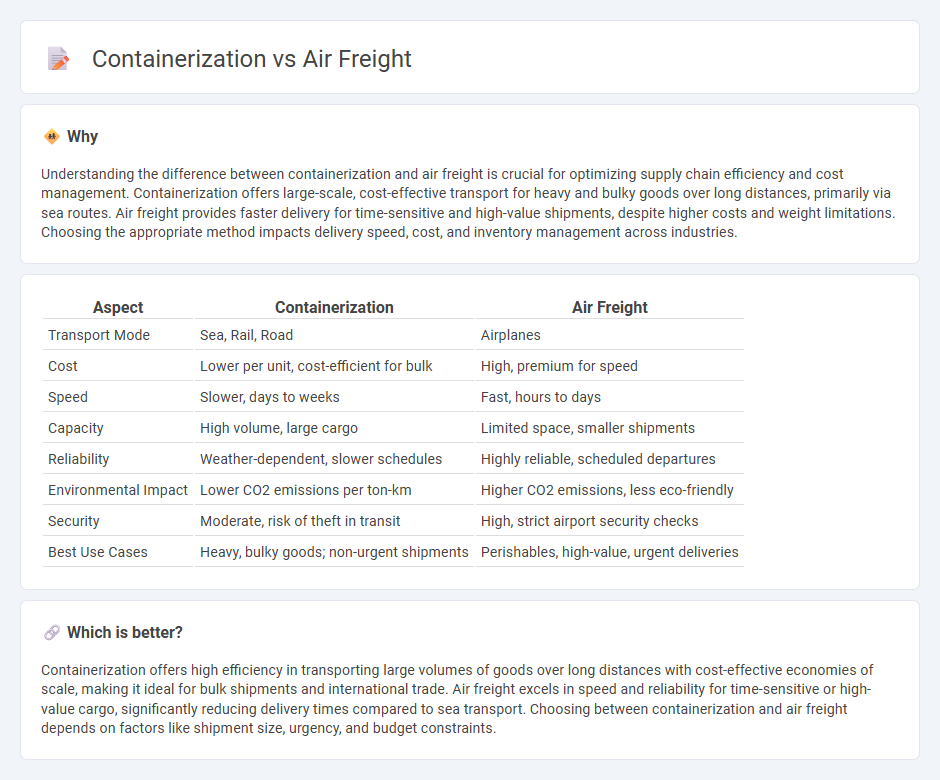
Containerization revolutionizes logistics by enabling standardized, efficient transport of large volumes of goods via ships and trucks, significantly reducing costs and transit times for heavy or bulky items. Air freight, on the other hand, offers unparalleled speed and reliability, making it ideal for high-value, time-sensitive shipments but at a higher cost and limited cargo capacity. Explore the advantages and use cases of containerization versus air freight to optimize your supply chain management.
Why it is important
Understanding the difference between containerization and air freight is crucial for optimizing supply chain efficiency and cost management. Containerization offers large-scale, cost-effective transport for heavy and bulky goods over long distances, primarily via sea routes. Air freight provides faster delivery for time-sensitive and high-value shipments, despite higher costs and weight limitations. Choosing the appropriate method impacts delivery speed, cost, and inventory management across industries.
Comparison Table
| Aspect | Containerization | Air Freight |
|---|---|---|
| Transport Mode | Sea, Rail, Road | Airplanes |
| Cost | Lower per unit, cost-efficient for bulk | High, premium for speed |
| Speed | Slower, days to weeks | Fast, hours to days |
| Capacity | High volume, large cargo | Limited space, smaller shipments |
| Reliability | Weather-dependent, slower schedules | Highly reliable, scheduled departures |
| Environmental Impact | Lower CO2 emissions per ton-km | Higher CO2 emissions, less eco-friendly |
| Security | Moderate, risk of theft in transit | High, strict airport security checks |
| Best Use Cases | Heavy, bulky goods; non-urgent shipments | Perishables, high-value, urgent deliveries |
Which is better?
Containerization offers high efficiency in transporting large volumes of goods over long distances with cost-effective economies of scale, making it ideal for bulk shipments and international trade. Air freight excels in speed and reliability for time-sensitive or high-value cargo, significantly reducing delivery times compared to sea transport. Choosing between containerization and air freight depends on factors like shipment size, urgency, and budget constraints.
Connection
Containerization revolutionized logistics by standardizing cargo sizes, enabling efficient transfer between different transport modes. Air freight relies on containerized units such as Unit Load Devices (ULDs) to streamline loading and unloading, optimize space, and enhance security. This integration reduces handling time, lowers costs, and improves global supply chain reliability.
Key Terms
Payload capacity
Air freight offers high-speed delivery but is limited by payload capacity, typically accommodating up to 1000 kg per aircraft on commercial routes. Containerization enables significantly larger payloads, with standard 20-foot containers holding up to 28,200 kg and 40-foot containers up to 30,480 kg, optimizing bulk transport. Explore the advantages of each method to determine the best solution for your cargo needs.
Transit time
Air freight offers significantly faster transit times, often delivering goods within 1-3 days, making it ideal for urgent shipments and perishable items. Containerization, primarily through sea freight, requires longer transit times ranging from 20 to 45 days but is more cost-effective for large volumes and non-urgent cargo. Explore detailed comparisons to determine the best shipping method for your logistics needs.
Handling requirements
Air freight demands specialized handling equipment such as forklifts with lifting capabilities for delicate and time-sensitive cargo, ensuring minimal damage. Containerization requires standardized containers and cranes designed for loading and unloading heavy, bulky goods efficiently while maintaining cargo security. Discover detailed handling protocols and equipment solutions tailored for both transport methods.
Source and External Links
Maersk Air Freight - Maersk Air Freight offers safe, efficient air transport of time-sensitive, high-value cargo with a vast global network and strong security measures ensuring cargo protection throughout the supply chain.
Air Freight: Shipping Charges, Rates, Cost & Quotes | Freightos - Air freight connects global markets faster than ocean freight, with rates typically ranging from $2.50 to $7.00 per kilogram depending on cargo type and current market conditions.
Pros & Cons of Air Freight: Cost, Speed, Shipment Visibility and More - Air freight is the fastest option for long-distance shipping offering quick delivery and reliable tracking, but it comes with significantly higher costs due to fuel, maintenance, and operational expenses.
 dowidth.com
dowidth.com